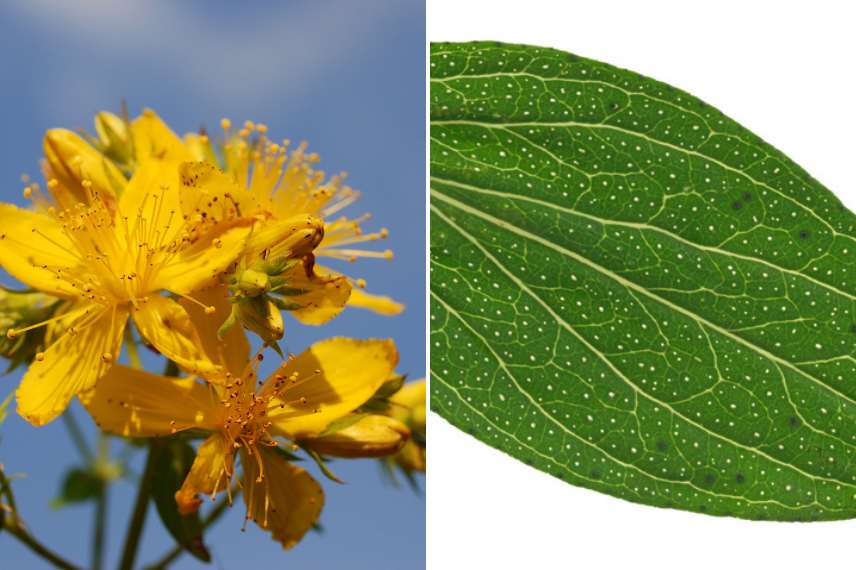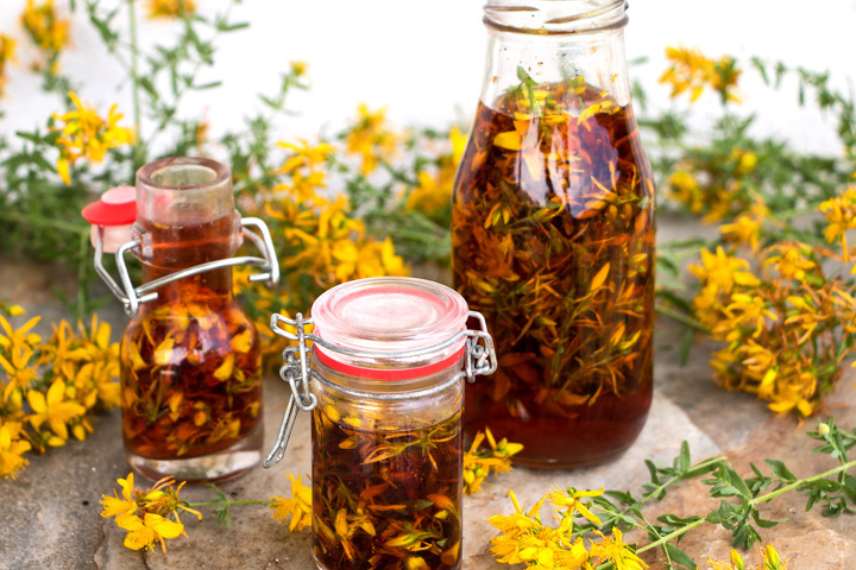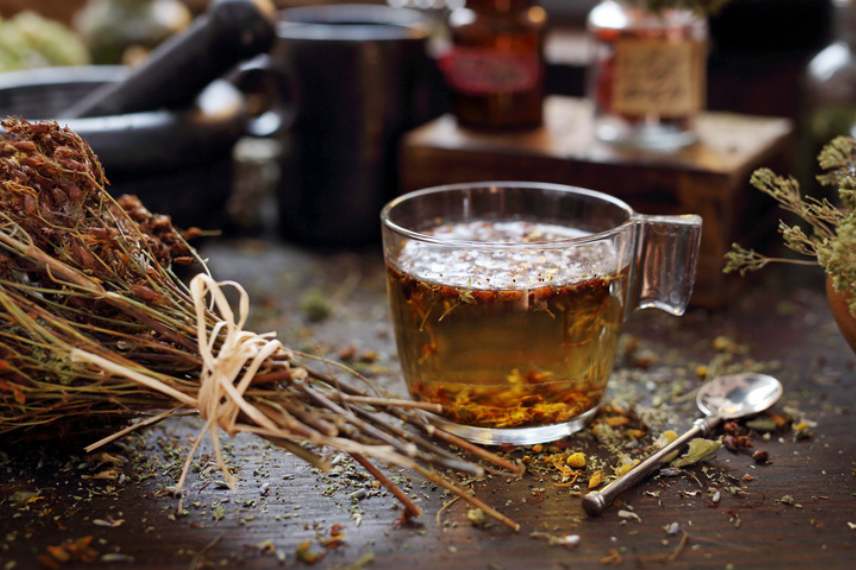
St John's Wort: what are its health benefits?
Tips on the medicinal uses of this yellow-flowering plant
Contents
For those who love perennial plants with yellow flowers, St. John’s Wort (Hypericum) is a must-have. Surely because it’s hard to find a plant so undemanding, so floriferous, so easy to grow, so resistant to cold, poor soils, drought, and so radiant. To these assets, we can add the fact that St. John’s Wort adapts to all exposures and adopts different habits, from vigorous ground cover to a bush imbued with a certain old-world charm. Not to mention that some of its species contain medicinal properties, recognised since antiquity for their anti-inflammatory, healing and antidepressant virtues.
Discover the benefits of St. John’s Wort as a medicinal plant, its uses for health and the precautions to take.
To go further: Hypericum, St. John’s Wort: planting, pruning and care.
Which species of St John's Wort to plant for its medicinal properties?
St John’s Wort (Hypericum), a member of the Hypericaceae family, boasts no fewer than 400 different species, not to mention hybrid varieties. However, not all of them possess medicinal properties. If you wish to bring light to your garden, opt for ornamental St John’s Worts, such as the renowned Hypericum ‘Hidcote’, which forms a small bush with a dense, spreading habit, offering bright yellow flowering from July to October. For rapid rock garden coverage, Hypericum calycinum is the ideal candidate.
Perforate St John’s Wort, the most widely used in herbal medicine
However, to benefit from St John’s Wort’s health properties, it’s the common St John’s Wort (Hypericum perforatum) that you should grow in your garden. This particularly hardy perennial reaches 1m in height with a 60cm spread and is highly floriferous. From May to September-October, it produces an abundance of bright yellow flowers with prominent stamens, followed by rather decorative red fruits. As for the deciduous leaves, they reveal translucent glands containing active compounds. This species of St John’s Wort is known by numerous vernacular names that hint at its virtues and benefits: devil’s scourge, demon chaser, fairy herb, carpenter’s herb, herb of a thousand holes, St John’s beard… The latter name suggesting that flowers picked on St John’s Day, i.e., 24th June, would be particularly rich in active molecules.

Flowers and “perforated” leaves of common St John’s Wort (Hypericum perforatum)
Other species such as Hypericum androsaemum (marsh St John’s Wort) or Hypericum olympicum (Olympic St John’s Wort) contain active compounds but are less studied and thus less popular in modern herbal medicine. It is primarily the use of perforate St John’s Wort that is recognised by science.
The components of St John’s Wort and their benefits
Perforate St John’s Wort (yet another name for Hypericum perforatum!) owes its benefits to a unique combination of active components, which work synergistically to provide a wide range of therapeutic effects. Among the most important, it is said to contain hypericin and hyperforin, renowned mood enhancers, which act on the nervous system to reduce symptoms of mild to moderate depression. St John’s Wort also contains flavonoids and tannic acid, powerful antioxidants with anti-inflammatory properties. Not to mention essential oils. All these components make St John’s Wort a plant with multiple benefits, both for mental wellbeing and physical health.
How to use St John's Wort?
St John’s Wort can be consumed and used in various ways, depending on individual needs and preferences.
When and How to Harvest St John’s Wort?
It is primarily the flowering tops that should be harvested in the garden or in the wild for medicinal use. The flowers and flower buds are ideally harvested from mid-June to mid-July, in the morning on a dry day, by cutting bunches with pruning shears about 5 cm from the tip. Choose stems without wilted flowers. These flowering tops of St John’s Wort can be used fresh or dried. When harvesting the flowers, a reddish juice tends to stain the fingers.

Harvesting the flowering tops of St John’s Wort
The leaves of perforate St John’s Wort can also be used, but only when dried.
To dry St John’s Wort, spread the flowers or leaves on trays or in crates and store them in a dark, well-ventilated, and dry place. If you’ve picked the flowering tops with longer stems, make loose bunches and hang them upside down in a dry, airy, and dark location.
How to Use St John’s Wort?
Whether fresh or dried, St John’s Wort flowers can be consumed in several ways. However, the leaves should only be used dried.
- As an infusion: 1 tablespoon of flowering tops per 150 ml of simmering water. Steep for 10 to 15 minutes before straining. Since this herbal tea doesn’t have a very pleasant taste, you can add a little honey. It is possible to drink 2 to 3 cups per day.
- As a vulnerary lotion: 2 tablespoons of St John’s Wort in 200 ml of simmering water. Steep for 10 to 15 minutes and let cool. This lotion is used for skin care (washing wounds, compresses for sunburn, minor burns, etc.). It can also be applied as compresses on sprains or bruises, covered with a bandage, for one to two hours.
- As a solarised oil or macerated oil: simply mix 100 g of fresh or dried flowering tops with 100 ml of vegetable oil (olive or other) in an airtight glass container. Let it macerate in sunlight for one month, then strain. The macerate will take on a lovely red colour. Store it away from light.
Note: A course of St John’s Wort typically lasts between 4 and 6 weeks. After a course, a break of 2 to 4 weeks is recommended before resuming if necessary.

St John’s Wort macerate
What are the health benefits of St John's Wort?
St John’s Wort is renowned for its effects on mood and mental health, but its benefits go far beyond!
Renowned as a natural antidepressant
Thanks to the hypericin and hyperforin it is believed to contain, St John’s Wort is often used to help treat mild to moderate depression. It is thought to reduce anxiety and promote better stress management. Indeed, it may help regulate the nervous system in cases of seasonal depression or reactive depression linked to overwork, stress, poor sleep, etc. It could contribute to restoring emotional balance, alleviating depressive states and improving overall mood.
This antidepressant property of St John’s Wort was already utilised in America as early as the 18th century. It was demonstrated by studies conducted in Germany in the 1980s. And since 2005, the WHO (World Health Organisation) has recognised the efficacy of St John’s Wort, consumed as a herbal tea, in treating mild depression.
Depending on the case, its effects may be felt after a few weeks or so.

St John’s Wort infusion is beneficial for helping to treat mild to moderate depression
An effective anti-inflammatory
For external use, the flowering tops, prepared as a maceration, are intended for massages reputed to be anti-inflammatory against rheumatism, bruises, joint and muscle pain. Local application may help reduce inflammation and relieve pain. This macerate is believed to have analgesic properties for localised pain caused by sciatica, osteoarthritis, arthritis, or simply muscle soreness.
A healing agent with antiseptic and soothing properties
As a lotion, thanks to its antiseptic and soothing properties, St John’s Wort is used for skin treatments. It can be applied to mild sunburns, minor burns and wounds, scrapes and grazes, insect bites, and skin irritations such as nappy rash in babies. The plant’s active compounds are thought to accelerate wound healing by reducing inflammation and promoting tissue regeneration. For mouth irritations, the herbal tea will be used.
Better sleep
St John’s Wort may promote relaxation and help improve sleep quality, particularly in cases of insomnia linked to stress or anxiety. It could facilitate restorative sleep.
Benefits for neuralgic-type pain
St John’s Wort may help manage neuropsychic symptoms related to neuralgia of all origins (facial, dental, etc.), which cause stress and mood disorders. It can thus be used as an infusion to help relieve fibromyalgia and other nerve pain.
What are the contraindications and precautions for St John's Wort?
Despite its many benefits, St John’s Wort is not suitable for everyone. Caution is therefore advised, and consulting a professional is always recommended before any prolonged use.
Drug Interactions
St John’s Wort may interact with many allopathic treatments, including:
- Antidepressants
- Oral contraceptives, whose effectiveness it may reduce
- Anticoagulants
- Immunosuppressants
Beware of Photosensitivity
St John’s Wort oil makes the skin more sensitive to UV rays due to hypericin. This photosensitivity may cause itching and/or burns. It is therefore essential to avoid sun exposure during regular or occasional use of St John’s Wort, and to protect the skin with clothing if applying lotion or macerate topically.
Not Recommended for Pregnant or Breastfeeding Women
As a precaution, it is best to avoid St John’s Wort during pregnancy and breastfeeding.
- Subscribe!
- Contents
































Comments